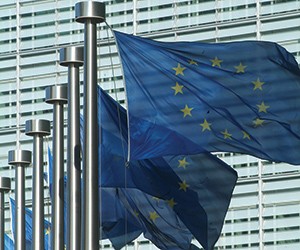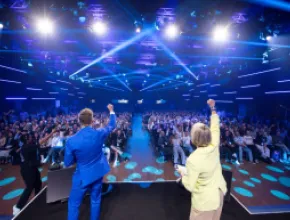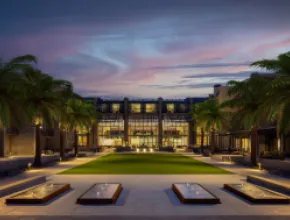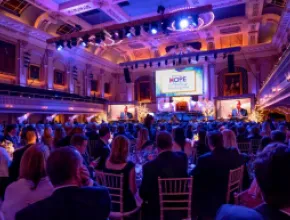Imagine a feast for a king, with endless treats and entertainment—the choices are overwhelming and it all looks so divine. Where to start?
This is what it might feel like for a planner with a meeting on deck in Belgium. In a country the size of Maryland, the question isn’t “What can I do?” but “How much can I fit in?”
Belgium boasts Brussels, the focus of the world’s attention as the European Union struggles with debt-induced growing pains; more trade organizations than anywhere except Washington, D.C., which recently started a “Power Cities Alliance” with Brussels; charming villages where monks have been making beer for hundreds of years; and an Antwerp fashion scene that rivals Paris.
Home base for the European Union and NATO, Brussels is the center of gravity in Belgium, and all other cities are measured by their distance from the capital. According to the Union of International Associations, Brussels is Europe’s most popular convention city and is second only to Singapore globally in terms of total meetings held in 2010.
“Brussels is close—the first asset is its location,” says Veronique Boyens, meetings and conventions manager, USA, for the Brussels CVB. “We are at the heart of Europe, in the middle of a high-speed train network. We are an hour and 20 minutes from Paris, less than two hours from Amsterdam or London, and two hours from Cologne. The airport is only eight miles from downtown, we have 11 daily flights from the East Coast of the U.S., and it only takes six-and-a-half hours to get here. In June, Brussels Airlines will start a new route from New York City.”
Brussels is designed for business but has managed to stay human-sized. Walking and public transportation rule, and unlike many European cities where the locals seem tourist-weary, visitors are warmly welcomed. Plus, although other European capitals get more ink, Brussels gives you the most bang for your buck.
“As the capital of Europe, it makes absolute sense for international associations to meet in Brussels because they’re close to the European Parliament and the European Commission, and a lot of international companies have chosen Brussels for their European headquarters,” Boyens says.
“We have 60 special event venues, we have 100 museums within downtown or close, and of course, cities like Bruges, Antwerp and Ghent are a half-hour away at most. Plus, most people speak English because it’s such an international city.”
Oh, and did we mention that 2012 is the year of gastronomy for Brussels and Wallonia, where there are dedicated food tours on the public trams, massive public art projects celebrating Belgian delicacies and a roving “taste magician” who will turn up in surprise locations to whip up Belgian fare on the street?
But let’s face it, despite a stellar location, most people hear “Belgian” and think beer or chocolate. Or if they’ve been to Europe before, they think of the mussels and fries concoction known as moules frites. So let’s explore Belgium just like your attendees will—one taste at a time.
Moules Frites to Magritte
If we’re talking mussels in Brussels, your first stop has to be at Chez Leon, which serves a half-ton of mussels every day from its Rue de Bouchers location near the Grand Place. Chez Leon can handle groups of up to 230 people. It also brews its own beer that comes straight from the barrel into your glass.
The Grand Place square is one of Brussels’ must-see sites, chock-a-block with baroque buildings like the Hotel de Ville, chocolate shops, museums and more little cellar restaurants hiding at the bottom of nondescript stairs than you thought possible.
If you’re lucky enough to show up in August in an even year, you’ll be treated to a three-day “flower carpet,” where millions of begonias cover the whole square in one of the largest flower tapestries in the world.
If the Grand Place has a medieval festival feel to it, that’s no mistake. During medieval times, jousting tournaments took place here before raucous crowds. Now, luckily, the biggest fights are over what restaurant serves the best Belgian specialties.
Brussels is a walkable city, but it’s nice to know that the main meeting space in Brussels, the brand-new SQUARE Conference Center, is just steps away from the Grand Place. SQUARE boasts 100,000 square feet of function space and a capacity to handle 3,000 people.
If your hunger—for culture or for food—isn’t satisfied yet, head over to the new Magritte Museum in the Royal Palace area, where you’ll feel like the majority of Belgium’s 5,000 “friteries” are selling fries on any single day. After all, fries were invented in Belgium by hungry fishermen who weren’t able to fish in iced-over lakes, so they settled for frying up potato wedges shaped like fish. Near the Royal Palace, street vendors hawk another Belgian specialty: hot fresh waffles with whipped cream, strawberries or whatever else your heart desires.
The Magritte Museum holds 200 of the surrealist artist’s works. The most famous one is a painting of a pipe titled This Is Not a Pipe. The Museum Cafe and Museum Brasserie are two of the most stylish eateries you’ll find in nearly all of Belgium, and the museum is available to groups in one of three private event spaces. The Magritte Room, where the painter’s works seemingly float in the air like dreams, is the most dramatic.
Within a stone’s throw of the Magritte Museum are a sculpture garden, the Museum of Musical Instruments, the Cinematek Museum, with nearly 60,000 films in its archives, and the Royal Museum of Fine Arts. The Musical Instrument Museum holds group tours in English by reservation, and you can either take your attendees through the history of music or focus on one type of instrument, such as guitars. The sound lab, where people get to make their own music (or try to) is a must for team building or a fun day out, and on the top floor, the indoor and outdoor MIM Restaurant provides visitors with a magnificent 360-degree view of Brussels.
Brews in brussels and bruges
Homer Simpson once famously said beer is the cause of and solution to life’s problems. In Belgium, beer is life itself. With more than 650 different varieties brewed in the country, many Belgian beers have special glasses that supposedly bring out a certain beer’s distinct flavors. To speak of a beer route here is silly because the entire country is dotted with breweries, but if you have the time, Chimay and Dinant are where you’ll want to spend the most time with groups, visiting monks who have been making specialty suds for centuries.
In the capital city near the Grand Place is the Brewery Museum, a working beer-making facility since 1900. Tours and tastings are available year-round. The brewery’s specialty is the Belgian beer known as Gueze, which some people say resembles champagne. Also on the Grand Place is Les Brasseurs de la Grand Place (Brewers of the Market), a famous pub and microbrewery.
If you’re still capable of walking in a straight line, head to Halles St. Gery. It used to be an indoor market but is now a massive bar with more beers than you can shake a tankard at, and the obelisk in the center is “kilometer zero,” the bull’s-eye used to measure all distances in Brussels. A great spot to finish the beer adventure is A La Mort Subite (At The Sudden Death), named after a card game some of the regular patrons played when the brasserie first opened in 1910. It’s probably the most famous bar in Belgium, and if you’re a professional beer drinker you’ll want to take home a souvenir or two.
In the meticulously preserved village of Bruges, a 50-minute train ride from Brussels, take in the romantic canals, medieval architecture and cobblestone streets before visiting the Halve Maan Brewery, the only family brewery in the center of Bruges that is still active. A family owned place that created the “Brugse Zot” style of beer, groups can do a 45-minute brewery tour or one of the many group-only offerings the brewery has on tap: guided tastings, beer-making seminars, a special evening program with costumed minstrels, and outdoor or indoor dining events.
Sometimes called “Venice of the North,” Bruge’s medieval town center may be a UNESCO World Heritage Site but that doesn’t mean the little city can’t host big meetings. In fact, the Congress Center is only minutes from the historic downtown and can handle up to 1,000 people, and some of the hotels, while leaning heavily toward boutique and B&Bs, accommodate meetings. Check out the swank and ideally located Kempinsky Hotel Dukes’ Palace or the offerings from Best Western and Crowne Plaza.
Chocolate, Diamonds and desiGners
If you love chocolate, stick around Bruges for awhile. The town that time forgot has 55 chocolate shops, a chocolate museum and even an annual chocolate festival.
Bruges is also home to self-styled “shock-o-latier” Dominique Persoone, who enjoys shaking up Belgium’s traditional chocolate-making trade. He invented, and this is no joke, a machine where people can inhale small bits of finely ground cocoa.
Persoone’s shop, the Chocolate Line, offers unusual flavor pairings and inventive, subtle sweets like chocolate lipstick and tequila-filled chocolate pots. The workshop is open so you can see the chocolatiers at work. And yes, you can sniff cocoa here just like the Rolling Stones once did.
The Choco-Story museum spotlights the long and surprising history of chocolate. Did you know that for the Mayans and the Aztecs, chocolate was the drink of the gods and cocoa beans were a means of payment? Visitors learn all about the production of chocolate, from truffles to bars heavier than some precious metals.
We’re not sure if diamonds or chocolates are a girl’s best friend, but Antwerp has boxes full of both. The Diamond District near the central train station is full of stores where diamonds are on display and jewelers set their precious stones in front of plate-glass windows. Think of it as very expensive performance art. Formerly a Jewish neighborhood, this is the place for the best matzah ball soup in Belgium.
Home to the master Flemish Baroque painters in days gone by, Antwerp has a reputation for being an especially hip place and brims with jazz clubs and cafes filled to the sidewalk with the creative class. The “Antwerp Six” put the Belgian minimalist-funky style on the fashion map, and the Fashion Department of the Royal Academy for Fine Arts of the Hogeschool Antwerp draws 6,000 designers and fashion buyers every year in June. For visitors, this means that the city is stuffed with boutiques selling tomorrow’s styles right now.
Antwerp also has loads of chocolate shops, including another location of the Chocolate Line. One local specialty that is a must is “Antwerp Hands,” which are sweet treats in the shape of hands, including shortcake cookies adorned with almonds or milk chocolate.
Back in Brussels, the chocaholism doesn’t stop. There are a number of Belgian chocolate walking tours that give attendees a chance to taste their way around the city, and at some of the big chocolate stores, including Planete Chocolat and Zabaar, groups can take advantage of chocolate-making classes.
No matter what attendees prefer—beer, moules frites, chocolate or all of the above—meetings in Belgium are sweet affairs indeed.
Josh Krist has lived in Europe, Japan and Southeast Asia, and has traveled extensively around the globe. He has worked for the Associated Press in Jerusalem and Paris, and is currently a freelance writer for Lonely Planet guidebooks and various travel magazines.






